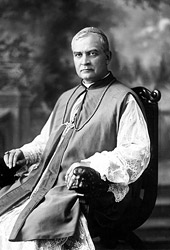Blessed Jurgis Matulaitis
Jurgis Matulaitis was born into a family of farmers on April 13, 1871 in the village of Lūginė, 5 kilometres to the north of Marijampolė. After completing primary and secondary school in Marijampolė, he left for Poland, where in 1889 he entered the Kielce gymnasium and in 1891 the Kielce seminary. The Tsarist regime closed that seminary in 1893, so he moved to the Warsaw seminary, where he graduated in 1895 with excellent marks. From there the young cleric was sent to St Petersburg Theological Academy and earned a masters degree with high honours.
In 1898, Jurgis Matulaitis was ordained a priest. A year later he began studies at the University of Fribourg in Switzerland, where in 1902 he defended a dissertation with top marks to earn a doctorate in theology. Later, Fr Matulaitis taught at the Kielce seminary. From 1905 to 1907, in Warsaw, he served as a high school chaplain and engaged in Christian social activities. He helped workers organize themselves, set up children’s shelters and assisted the poor, all without regard to differences of nationality or religion.
From 1907 to 1911, Jurgis Matulaitis taught sociology at St Petersburg Theological Academy. It was here that he decided to become a Marian Father and work to renew the Marian Order, which had nearly died out. He took his first vows in 1909, and in 1911 was elected Superior General of the order. He resided in Warsaw from 1914 to 1918, during which time he founded a monastery in Bielany and lent support for an orphanage.
Returning to Lithuania in 1918, Jurgis Matulaitis put the war-ravaged Marian monastery at Marijampolė in order and founded the Congregation of the Sisters of the Immaculate Conception of the Blessed Virgin Mary of the Poor. On December 1, 1918, he was consecrated a bishop and appointed head of the diocese of Vilnius, a post he held for 7 years while also leading the Marian Fathers. In 1924, he founded the Congregation of Handmaidens of Jesus in the Eucharist.
In 1925, Jurgis Matulaitis resigned as bishop of Vilnius. Shortly after, Pope Pius XI made him an archbishop and appointed him Apostolic Visitor to Lithuania. In that role, he contributed greatly to improving relations between Lithuania and the Holy See, to the creation of a Lithuanian ecclesiastical province and to the drafting of a concordat. He died in Kaunas on January 27, 1927.
Already during the funeral, Canon Juozas-Tumas Vaižgantas (1869–1933) of Kaunas referred to Jurgis Matulaitis as a saint. Pope Pius XI also spoke of Jurgis Matulaitis as “a truly holy man”. His fame of sanctity spread ever more after his body was transferred on October 24, 1934, from the crypt of the Kaunas Cathedral to the Sacred Heart Chapel (now the Chapel of Blessed Jurgis Matulaitis) at the Church of St Michael the Archangel in Marijampolė. The sarcophagus containing the remains of the holy archbishop was thus more accessible, and people came to his tomb more frequently to ask his help in obtaining graces. Soon written notes expressing gratitude for special graces began to appear on his sarcophagus. This was the stimulus to begin his process of beatification.
The cause for beatification was opened in Rome in 1953. By 1978, some 900 declarations and notes of gratitude had been submitted regarding spiritual and corporal graces received through the intercession of Jurgis Matulaitis, mostly cures of a variety of illnesses. In 1982, Pope John Paul II publicly recognized that the virtues of Jurgis Matulaitis were truly “heroic”, and granted him the title “Venerable Servant of God”. The Holy See then carried out an investigation of the miraculous graces attributed to his intercession, and in 1987 the Holy Father declared Archbishop Jurgis Matulaitis blessed.
The following is an except from Pope John Paul II’s homily during the Mass of Beatification for Blessed Jurgis Matulaitis on June 28, 1987: “In the Gospel according to Matthew we read: ‘Whoever does not take up his cross and follow after me is not worthy of me. Whoever finds his life will lose it, and whoever loses his life for my sake will find it.’ That is the best and most precise summary of Blessed Jurgis’s life and work. Throughout his 56 years of life, he tried to be worthy of Christ. And so he took up his cross – and the cross that he had to take up and carry during those times of great change was certainly heavy. He took up that cross and he followed Christ. And he was ready, in many different ways, to lose his life for Christ, as is proved by his works and his words, indeed all of his pastoral service. He did not spare himself, did not seek to preserve his life. Often he was ready to lose it. And precisely for that reason, he found the fullness of life that a person can only find in Christ.”








